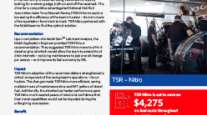Diesel Rises 4.8¢ to $3.868 a Gallon; Gasoline Also Climbs for a Second Week
This story appears in the Sept. 12 print edition of Transport Topics.
The average price paid for a gallon of U.S. retail diesel rose 4.8 cents a gallon to $3.868 last week, the second straight increase, the Department of Energy reported.
The retail average for regular gasoline also rose for a second week, to $3.674, after a 4.7-cent jump, DOE’s Energy Information Administration said after its Sept. 5 survey of fueling stations.
Both fuels remain below their 2011 high points in early May but substantially above a year ago. A diesel analyst for a major truck-stop chain attributed the rebound to pump prices catching up with wholesale markets.
The increase was “part of the retail lag between diesel prices and the NYMEX heating oil contract,” said Bruce Gress, director of petroleum risk management for Pilot Flying J Travel Centers, Knoxville, Tenn.
For most of July and into early August, the New York Mercantile Exchange priced futures for distillate products at $3.10 a gallon, with very little variation. However, heating oil then fell to less than $2.80 a gallon before moving back above $3 at the end of August.
“We locked in several weeks at lower prices, but now we’re back to roughly the $3.05 mark,” Gress said.
The two weeks of increases for diesel totaling 5.8 cents a gallon followed four weeks of declines. The year’s high was $4.124 on May 2. A year earlier, the average for trucking’s main fuel was $2.931 a gallon.
Gasoline peaked at $3.965 on May 9, EIA said, but a year ago it was $2.682.
Flatbed executive Richard Stidham, president of Stidham Trucking Inc., Yreka, Calif., said fuel is always the top issue for his fleet of 75 tractors. His home office is in the state that often has the nation’s highest fuel prices.
The California diesel average jumped 10 cents a gallon last week to $4.058, EIA said.
Stidham said he tries to have his drivers fill up in one of the states that borders on California. He said that can save him 10 cents to 15 cents a gallon. More profoundly, Stidham said he has been updating his company’s specifications for tractor purchases regularly since 2003.
“We’ve taken off all of the wind-drag stuff we possibly can. We used to run those long hoods, but now they’re sloped and with fairings, wherever possible,” Stidham said, adding that he also has switched to automatic transmissions to optimize shifting.
Fuel is always among a trucking company’s most pressing concerns, said Steve Spade, director of maintenance for Gateway Distribution Inc., a Cincinnati-based less-than-truckload carrier.
However, while swings of 5 cents to 8 cents a week used to be extreme, Spade said he now thinks of them as “very tolerable.”
He said it is only when there are spikes of about 10 cents or more that the company cannot recoup most of it through its fuel surcharge program.
Gateway has 55 trucks.
Gress described diesel prices as “trading sideways,” and he predicted limited volatility in the near term.
“We’re range-bound. There are a lot of reasons for there being a floor under prices and a lot why they can’t break out on the higher side,” Gress said. “The economy can’t stand it if oil prices go much higher, and producers can’t stand to go lower.”
Meanwhile, as they have since Aug. 22, crude oil futures on the New York Mercantile Exchange remained between $85 and $90 a barrel, closing at $89.05 on Sept. 8.
The peak for crude oil in New York was $113.93 on April 29, whereas the lowest close over the past 52 weeks was $73.52 on Sept. 21. As recently as July 26, crude closed at $99.59 a barrel.
EIA said Sept. 7 in its Short-Term Energy Outlook that it expects retail on-highway diesel fuel prices to average $3.85 this year and $3.87 a gallon in 2012. Diesel averaged $2.99 a gallon last year.
The report also said gasoline will average $3.56 this year, up from $2.78 a gallon last year.
EIA issued another report the same day documenting the increase in shipments of U.S. refined products abroad. More than 2 million barrels a day of all fuels are being exported, the Energy Department said, adding that the increase in distillate fuels, including diesel, is especially pronounced.
In 2000, about 5% of U.S.-produced distillates were exported, but now the level is about 20%, DOE said.




